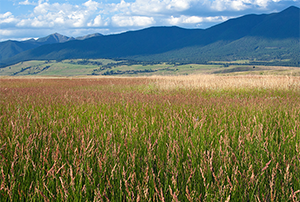Northern Plains Grassland
The Northern Great Plains landscape is vast, spanning more than 180 million acres. Crossing multiple states in North America and parts of Canada, the Northern Great Plains is known for its lush grasslands that are home to a number of waterfowl and non-game species.

The Northern Great Plains landscape is vast, spanning more than 180 million acres. Crossing multiple states in North America and parts of Canada, the Northern Great Plains is known for its lush grasslands that are home to a number of waterfowl and non-game species.
However, the shortgrass and mixed grass bird community has suffered declines over several decades. In fact, many species have been proposed for listing under the Endangered Species Act.
The Natural Resources Conservation Service (NRCS) is partnering with the Northern Great Plains Joint Venture (NGPJV) to identify intact grassland habitats under the most threat for conversion to tilled agriculture. The project region includes several thousand acres in South Dakota and North Dakota.
By focusing on grassland habitat improvement, the partnership will work in “Grassland Conservation Areas” by utilizing species and habitat models to guide conservation actions benefiting Chestnut-collared Longspur, Baird’s Sparrow and Sprague’s Pipit.
In an effort to address lands that have already been tilled for agriculture, the NGPJV partnership will work to enhance landscape connectivity, soil health and water quality through promoting the return of key areas back into grassland cover.
Landowners in the Northern Plains will help restore the grassland landscape by improving rangeland conditions through implementing sustainable grazing practices, prescribed burning, habitat restoration for wildlife and addressing water quality and quantity needs for livestock.
NRCS offers technical and financial assistance to help landowners improve the health of rangelands. This assistance helps producers plan and implement a variety of conservation activities, or practices, that benefit the landscape and many of the game and non-game species that depend on it.
Technical assistance is free to producers. The agency’s staff of experts and conservation partners work side-by-side with producers to develop a conservation plan. Each plan focuses on implementing conservation practices to improve ranching operations while improving rangelands. These plans provide a roadmap for how to use a system of conservation practices to meet natural resource and production goals.
Financial assistance helps producers pay for the adoption of conservation systems. Common conservation practices include prescribed burning, prescribed grazing, conservation cover and brush management.
These efforts in the Northern Plains Grassland are part of the Working Lands for Wildlife (WLFW) partnership, a collaborative approach to conserve habitat on working lands. WLFW is providing technical and financial assistance through the Environmental Quality Incentives Program, a conservation program of the Farm Bill, the largest funding source for conservation on private lands.
When the health of the Northern Plains Grassland landscape is improved, many species benefit, including Chestnut-collared Longspur, Baird’s Sparrow and Sprague’s Pipit. Additional species that will benefit are the burrowing owl, ferruginous hawk, bobolink, greater prairie-chicken and pollinators.

